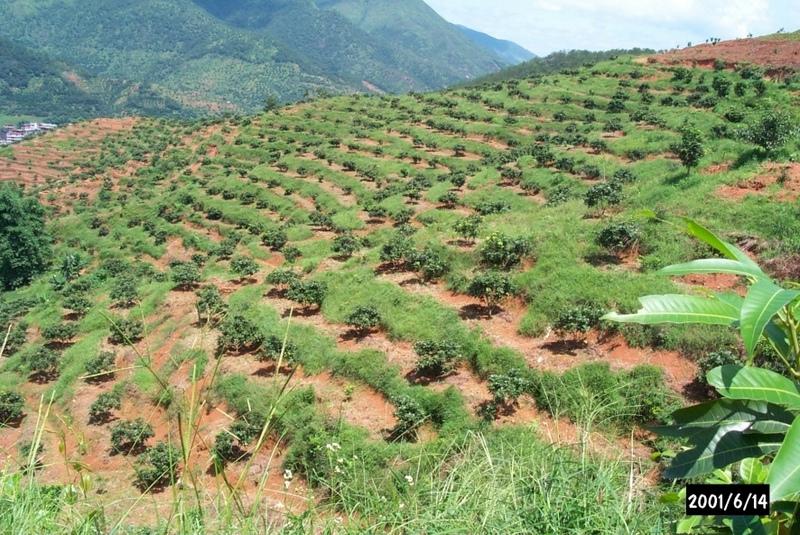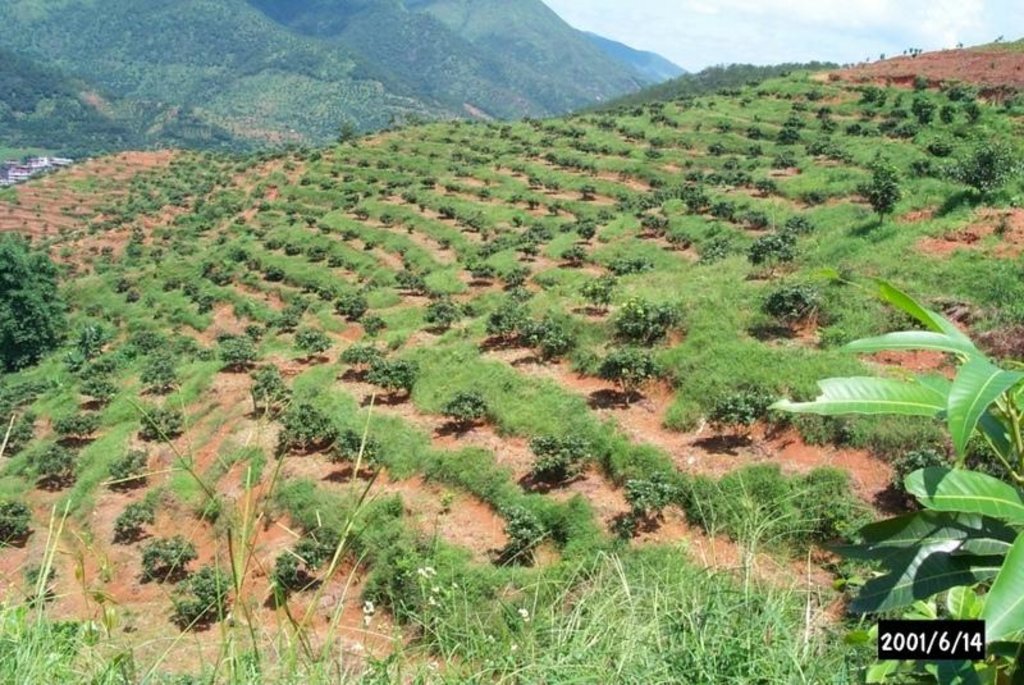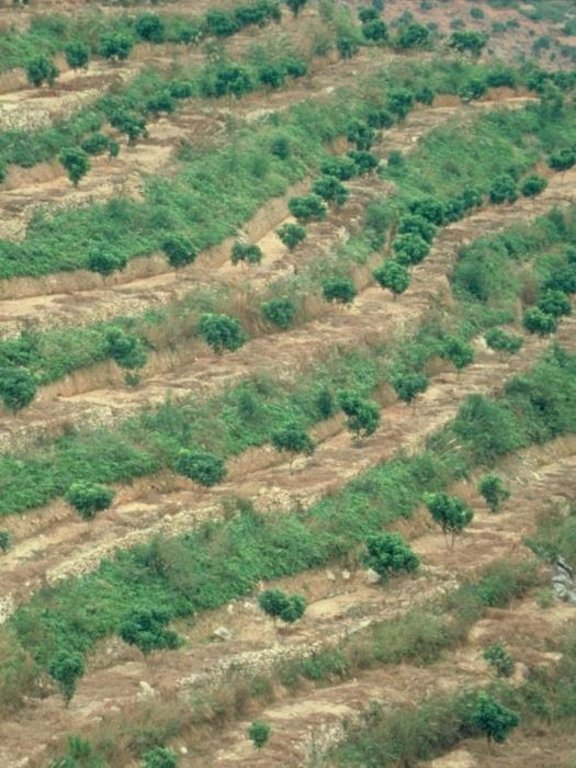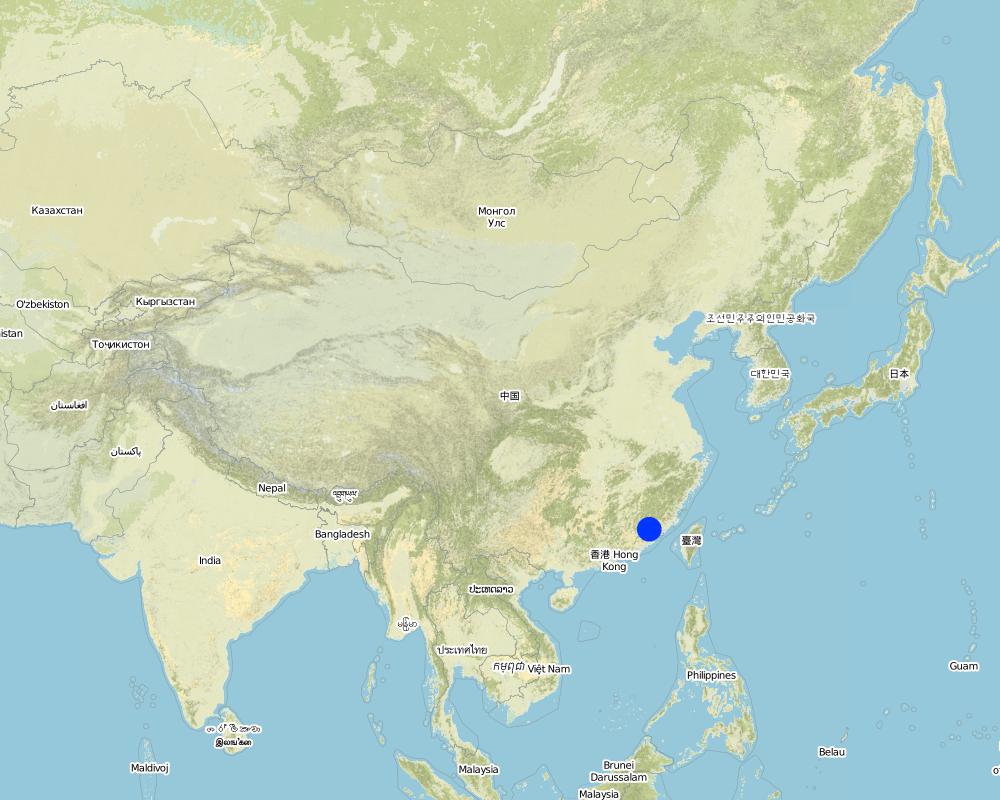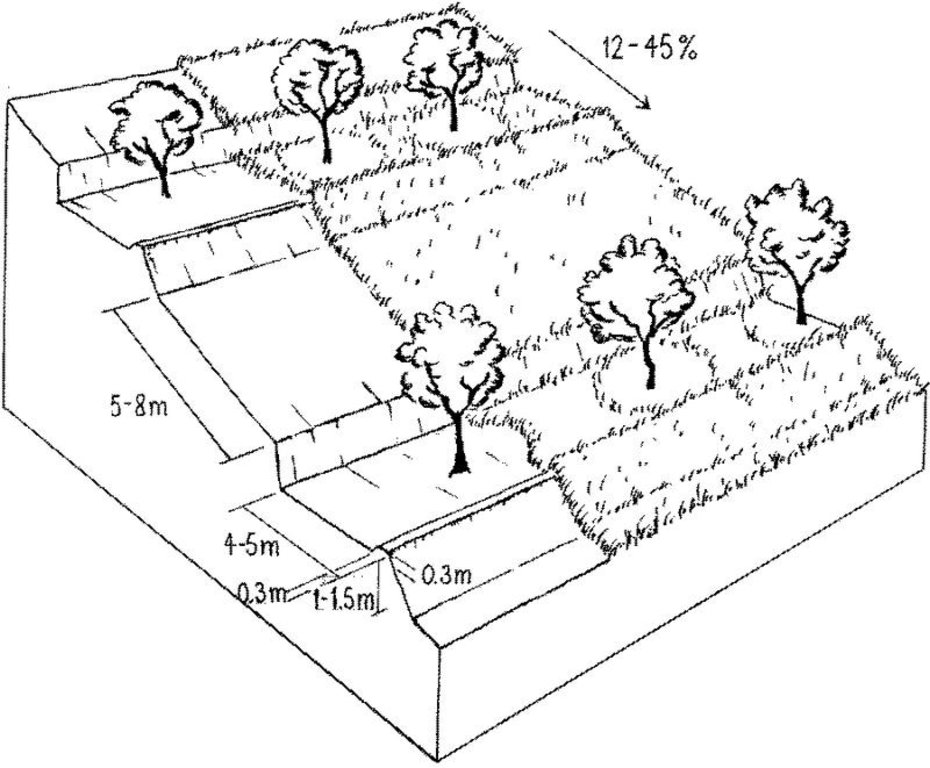Orchard terraces with bahia grass cover [China]
- Creation:
- Update:
- Compiler: Zhanguo Bai
- Editor: –
- Reviewers: David Streiff, Deborah Niggli, Alexandra Gavilano
Bahia grass interplanted in orchard
technologies_1106 - China
View sections
Expand all Collapse all1. General information
1.2 Contact details of resource persons and institutions involved in the assessment and documentation of the Technology
Key resource person(s)
SLM specialist:
Liu Zhengming
Soil Conservation Office of Yongchun County
China
SLM specialist:
Nie Bijuan
Fujian Soil and Water Conservation Experimental Station
China
SLM specialist:
Yang Xuezhen
Fujian Soil and Water Conservation Experimental Station
China
SLM specialist:
Name of project which facilitated the documentation/ evaluation of the Technology (if relevant)
Book project: where the land is greener - Case Studies and Analysis of Soil and Water Conservation Initiatives Worldwide (where the land is greener)Name of the institution(s) which facilitated the documentation/ evaluation of the Technology (if relevant)
ISRIC World Soil Information (ISRIC World Soil Information) - NetherlandsName of the institution(s) which facilitated the documentation/ evaluation of the Technology (if relevant)
Soil Conservation Office of Yongchun (SCOY) - ChinaName of the institution(s) which facilitated the documentation/ evaluation of the Technology (if relevant)
Fujian Soil and Water Conservation Office (Fujian Soil and Water Conservation Office) - China1.3 Conditions regarding the use of data documented through WOCAT
The compiler and key resource person(s) accept the conditions regarding the use of data documented through WOCAT:
Yes
2. Description of the SLM Technology
2.1 Short description of the Technology
Definition of the Technology:
Rehabilitation of degraded hillsides through the establishment of fruit trees on slope-separated orchard terraces, with bahia grass planted as protective groundcover.
2.2 Detailed description of the Technology
Description:
In this case study orchards were established between 1991 and 1992 on degraded and unproductive hillsides (wasteland), with slopes of 12-45%. This was achieved by constructing level beds on the contour, mainly as continuous slope-separated orchard terraces, but in some cases as individual planting platforms. Terrace construction was generally undertaken by hand using hoes and shovels.
Purpose of the Technology: A typical terrace has a 4-5 m wide bed and a 1.0-1.5 m high riser. Commonly, a raised earth lip (0.3 m high) is constructed on the terrace edge to retain rainwater. The terrace riser walls are not protected. Even before terrace construction there was little topsoil and in some places the upper subsoil had been lost to erosion. The establishment of fruit trees (lychee, Litchi chinensis and longan, Dimocarpus longan) therefore required deep planting holes (1 m3), filled with organic matter/manure, into which seedlings were planted. In subsequent years additional large quantities of organic matter/manure were applied in circular trenches to the side of the trees, succeeding trenches being gradually further away as the trees grew. Bahia grass (Paspalum notatum) was planted for SWC purposes as a cover crop, to stabilise terrace risers and to improve soil fertility. It has not been used for fodder in this case. The germination rate of bahia grass seeds is comparatively low; therefore instead of direct seeding, nurseries were established to produce seedlings. The bahia grass seedlings were transplanted onto the terrace risers and beds (leaving a space around each fruit tree) and on the hillside slopes between the terraces. The grass grew and spread quickly, restoring a protective vegetative cover following terrace construction.
Natural / human environment: The primary overall purpose of the technology was to rehabilitate degraded hillsides through the planting of economically valuable fruit trees. Terracing reduces soil erosion while retaining most of the rainwater. The application of organic matter creates improved rooting conditions, while restoring and maintaining soil fertility. The bahia grass further provides protective groundcover preventing splash erosion, increasing surface roughness, and thereby slowing down runoff velocity, while contributing to the restoration of the soil’s biological, chemical and physical properties. Irrigation ditches dug along the terraces help to reduce erosion further. This project was planned by SWC specialists: around 6,000 families were allocated orchard plots and provided with seedlings at a subsidised price.
2.3 Photos of the Technology
2.5 Country/ region/ locations where the Technology has been applied and which are covered by this assessment
Country:
China
Region/ State/ Province:
Fujian Province
Further specification of location:
Yongchun County
Specify the spread of the Technology:
- evenly spread over an area
If the Technology is evenly spread over an area, specify area covered (in km2):
55.0
If precise area is not known, indicate approximate area covered:
- 10-100 km2
Comments:
Total area covered by the SLM Technology is 55 km2.
This is a part of the comprehensive development of Shan Huxi small watershed.
Map
×2.6 Date of implementation
If precise year is not known, indicate approximate date:
- less than 10 years ago (recently)
2.7 Introduction of the Technology
Specify how the Technology was introduced:
- through projects/ external interventions
Comments (type of project, etc.):
The technology comes from the soil conservation theory books and accumulated experiences over years.
3. Classification of the SLM Technology
3.1 Main purpose(s) of the Technology
- reduce, prevent, restore land degradation
3.2 Current land use type(s) where the Technology is applied
Land use mixed within the same land unit:
Yes
Specify mixed land use (crops/ grazing/ trees):
- Agroforestry

Cropland
- Annual cropping
- Tree and shrub cropping
Annual cropping - Specify crops:
- fodder crops - grasses
Tree and shrub cropping - Specify crops:
- stone fruits (peach, apricot, cherry, plum, etc)
Specify:
Longest growing period in days: 365Longest growing period from month to month: May - Sep

Forest/ woodlands
Products and services:
- Timber
- Fruits and nuts
- Nature conservation/ protection
Comments:
Crop: bahia grass
Tree and shrub cropping: lychee, Litchi chinensis and longan, Dimocarpus longan
Major land use problems (compiler’s opinion): Degraded and unproductive hillside slopes (wasteland), with low and declining soil fertility, subject to severe soil erosion
(sheet, rill, gully and mass movement) during periods of heavy and prolonged rainfall.
Major land use problems (land users’ perception): Low fruit yield and little income after consideration of input.
Problems / comments regarding forest use: The farmers\' consciousness of soil conservation are gradually improved and their ability of forest protection are also increased.
Forest products and services: timber, fruits and nuts, nature conservation / protection
Constraints of wasteland (before SWC)
Forest/ woodlands: Also nature conservation / protection
3.4 Water supply
Water supply for the land on which the Technology is applied:
- mixed rainfed-irrigated
3.5 SLM group to which the Technology belongs
- improved ground/ vegetation cover
- hillside stabilizing and restoration
3.6 SLM measures comprising the Technology

agronomic measures
- A7: Others

vegetative measures
- V5: Others

structural measures
- S1: Terraces
Comments:
Main measures: agronomic measures, vegetative measures, structural measures
Secondary measures: management measures
3.7 Main types of land degradation addressed by the Technology

soil erosion by water
- Wt: loss of topsoil/ surface erosion
- Wg: gully erosion/ gullying
- Wm: mass movements/ landslides

chemical soil deterioration
- Cn: fertility decline and reduced organic matter content (not caused by erosion)
Comments:
Main type of degradation addressed: Wt: loss of topsoil / surface erosion, Wg: gully erosion / gullying, Wm: mass movements / landslides, Cn: fertility decline and reduced organic matter content
Main causes of degradation: deforestation / removal of natural vegetation (incl. forest fires), land tenure (land subdivision)
Secondary causes of degradation: over-exploitation of vegetation for domestic use, other human induced causes (specify) (agricultural causes), poverty / wealth (lack of captial), education, access to knowledge and support services (lack of knowledge)
3.8 Prevention, reduction, or restoration of land degradation
Specify the goal of the Technology with regard to land degradation:
- reduce land degradation
Comments:
Main goals: mitigation / reduction of land degradation
4. Technical specifications, implementation activities, inputs, and costs
4.1 Technical drawing of the Technology
Technical specifications (related to technical drawing):
Fruit trees on slope-separated terraces with a spacing of 5-8 metres between (dependent on slope). Terrace risers and beds are protected by the fast spreading bahia grass (right): note a grass-free space is maintained around each tree.
Technical knowledge required for field staff / advisors: high
Technical knowledge required for land users: moderate
Main technical functions: control of raindrop splash, reduction of slope angle, improvement of ground cover, increase in organic matter, increase in soil fertility, control of dispersed runoff
Secondary technical functions: increase of surface roughness, increase / maintain water stored in soil, improvement of soil structure
Agronomic measure: organic matter application
Vegetative measure: aligned trees
Vegetative material: T : trees / shrubs
Vegetative measure: dispersed grass
Vegetative material: T : trees / shrubs
Width within rows / strips / blocks (m): 6
Vegetative measure: Vegetative material: T : trees / shrubs
Vegetative measure: Vegetative material: T : trees / shrubs
Fruit trees / shrubs species: longan, lychee
Grass species: bahia
Slope (which determines the spacing indicated above): 16.00%
If the original slope has changed as a result of the Technology, the slope today is (see figure below): 12.00%
Gradient along the rows / strips: 9.00%
Terrace: forward sloping
Height of bunds/banks/others (m): 1-1.5
Width of bunds/banks/others (m): 4-5
Construction material (earth): Using earth for the construction can reduce investment.
Slope (which determines the spacing indicated above): 25%
If the original slope has changed as a result of the Technology, the slope today is: 20%
Lateral gradient along the structure: 6%
For water harvesting: the ratio between the area where the harvested water is applied and the total area from which water is collected is: 1:20
Vegetation is used for stabilisation of structures.
Other type of management: Changing land use patterns - Mountain and hilly areas closure for recover of the forest and grass.
Author:
Mats Gurtner
4.2 General information regarding the calculation of inputs and costs
Specify currency used for cost calculations:
- USD
Indicate average wage cost of hired labour per day:
3.00
4.3 Establishment activities
| Activity | Timing (season) | |
|---|---|---|
| 1. | 2.On each terrace one line of fruit trees was established. Deep planting | winter of 1991 |
| 2. | 2.Fruit tree seedlings were planted. Spacing between trees was | spring of 1992 |
| 3. | 3.Bahia grass was transplanted onto the terraced hillside | spring of 1992 |
| 4. | Terraces were constructed by hand.Soil was excavated from the upper portion of the terrace and used to build up the lower portion behind the terrace riser wall to create a level platform (bed). Part of the excavated soil was used to build a terrace lip. | winter of 1991 |
| 5. | land preparation for the grass planting | winter of 1991 |
| 6. | hill closure | Nov. 1999 |
4.4 Costs and inputs needed for establishment
| Specify input | Unit | Quantity | Costs per Unit | Total costs per input | % of costs borne by land users | |
|---|---|---|---|---|---|---|
| Labour | Voluntary and paid | ha | 1.0 | 840.0 | 840.0 | 100.0 |
| Plant material | Bahia transplants | ha | 1.0 | 435.0 | 435.0 | |
| Plant material | Fruit tree seedlings | ha | 1.0 | 350.0 | 350.0 | 60.0 |
| Fertilizers and biocides | fertilizer | ha | 1.0 | 145.0 | 145.0 | 100.0 |
| Fertilizers and biocides | compost/manure | ha | 1.0 | 70.0 | 70.0 | 100.0 |
| Total costs for establishment of the Technology | 1840.0 | |||||
| Total costs for establishment of the Technology in USD | 1840.0 | |||||
If land user bore less than 100% of costs, indicate who covered the remaining costs:
NA
Comments:
Duration of establishment phase: 24 month(s)
4.5 Maintenance/ recurrent activities
| Activity | Timing/ frequency | |
|---|---|---|
| 1. | 2.Digging trenches by the side of the fruit trees and filling with organic | |
| 2. | prune, fertilize, pest control for the fruit trees of Longan and Litchi | spring, autumn and winter /3 times/year |
| 3. | grass plantation, fertilizaion | spring and summer /3 times/year |
| 4. | Filling any gaps in the bahia grass. | |
| 5. | In the first 1–2 years maintenance also involves replacing any fruit tree | |
| 6. | Weeding around the trees. | |
| 7. | Repairing terraces damaged by storms. | after raining season/4 times/year |
| 8. | regular inspection and management | Jan. 1991 / 6 times/year |
4.6 Costs and inputs needed for maintenance/ recurrent activities (per year)
| Specify input | Unit | Quantity | Costs per Unit | Total costs per input | % of costs borne by land users | |
|---|---|---|---|---|---|---|
| Labour | Voluntary and paid | ha | 1.0 | 144.0 | 144.0 | 100.0 |
| Plant material | Bahia transplants | ha | 1.0 | 58.0 | 58.0 | 100.0 |
| Plant material | Fruit tree seedlings | ha | 1.0 | 36.0 | 36.0 | 100.0 |
| Fertilizers and biocides | fertilizer | ha | 1.0 | 84.0 | 84.0 | 100.0 |
| Fertilizers and biocides | biocides | ha | 1.0 | 10.0 | 10.0 | 100.0 |
| Fertilizers and biocides | compost/manure | ha | 1.0 | 44.0 | 44.0 | 100.0 |
| Total costs for maintenance of the Technology | 376.0 | |||||
| Total costs for maintenance of the Technology in USD | 376.0 | |||||
If land user bore less than 100% of costs, indicate who covered the remaining costs:
NA
Comments:
Machinery/ tools: hoe, shovel
For establishment: 200 person days for terrace construction, 100 for digging pits and planting trees, 50 for transplanting
bahia grass. For maintenance: 15 person days for terrace maintenance, 40 for digging organic matter trenches, 5 for
bahia grass gap filling. The SWC department produces bahia transplants in nurseries; these are then distributed to the
farmers.
4.7 Most important factors affecting the costs
Describe the most determinate factors affecting the costs:
steep slope and lots of civil work.
5. Natural and human environment
5.1 Climate
Annual rainfall
- < 250 mm
- 251-500 mm
- 501-750 mm
- 751-1,000 mm
- 1,001-1,500 mm
- 1,501-2,000 mm
- 2,001-3,000 mm
- 3,001-4,000 mm
- > 4,000 mm
Agro-climatic zone
- humid
5.2 Topography
Slopes on average:
- flat (0-2%)
- gentle (3-5%)
- moderate (6-10%)
- rolling (11-15%)
- hilly (16-30%)
- steep (31-60%)
- very steep (>60%)
Landforms:
- plateau/plains
- ridges
- mountain slopes
- hill slopes
- footslopes
- valley floors
Altitudinal zone:
- 0-100 m a.s.l.
- 101-500 m a.s.l.
- 501-1,000 m a.s.l.
- 1,001-1,500 m a.s.l.
- 1,501-2,000 m a.s.l.
- 2,001-2,500 m a.s.l.
- 2,501-3,000 m a.s.l.
- 3,001-4,000 m a.s.l.
- > 4,000 m a.s.l.
Indicate if the Technology is specifically applied in:
- not relevant
5.3 Soils
Soil depth on average:
- very shallow (0-20 cm)
- shallow (21-50 cm)
- moderately deep (51-80 cm)
- deep (81-120 cm)
- very deep (> 120 cm)
Soil texture (topsoil):
- coarse/ light (sandy)
Topsoil organic matter:
- medium (1-3%)
- low (<1%)
5.6 Characteristics of land users applying the Technology
Market orientation of production system:
- commercial/ market
Off-farm income:
- 10-50% of all income
Relative level of wealth:
- average
- rich
Level of mechanization:
- manual work
- animal traction
Indicate other relevant characteristics of the land users:
Population density: 200-500 persons/km2
Annual population growth: < 0.5%
5% of the land users are very rich and own 10% of the land.
40% of the land users are rich and own 35% of the land.
50% of the land users are average wealthy and own 45% of the land.
5% of the land users are poor and own 10% of the land.
Off-farm income specification: off-farm income is mainly from factory labour
5.7 Average area of land used by land users applying the Technology
- < 0.5 ha
- 0.5-1 ha
- 1-2 ha
- 2-5 ha
- 5-15 ha
- 15-50 ha
- 50-100 ha
- 100-500 ha
- 500-1,000 ha
- 1,000-10,000 ha
- > 10,000 ha
5.8 Land ownership, land use rights, and water use rights
Land ownership:
- state
Land use rights:
- leased
6. Impacts and concluding statements
6.1 On-site impacts the Technology has shown
Socio-economic impacts
Production
crop production
Income and costs
farm income
workload
Other socio-economic impacts
input constraints
Comments/ specify:
organic matter/manure
Socio-cultural impacts
community institutions
national institutions
conflict mitigation
Ecological impacts
Water cycle/ runoff
harvesting/ collection of water
Comments/ specify:
rainwater retention
surface runoff
Quantity before SLM:
70
Quantity after SLM:
35
Soil
soil moisture
soil cover
soil loss
Quantity before SLM:
24.3
Quantity after SLM:
3
soil organic matter/ below ground C
Other ecological impacts
erosion due to raindrop splash
competition between fruit trees and bahia grass
6.2 Off-site impacts the Technology has shown
reliable and stable stream flows in dry season
downstream flooding
downstream siltation
6.4 Cost-benefit analysis
How do the benefits compare with the establishment costs (from land users’ perspective)?
Short-term returns:
slightly positive
Long-term returns:
very positive
How do the benefits compare with the maintenance/ recurrent costs (from land users' perspective)?
Short-term returns:
slightly positive
Long-term returns:
very positive
6.5 Adoption of the Technology
- > 50%
If available, quantify (no. of households and/ or area covered):
6593 Households (56 percent of the area)
Of all those who have adopted the Technology, how many did so spontaneously, i.e. without receiving any material incentives/ payments?
- 11-50%
Comments:
88% of land user families have adopted the Technology with external material support
5755 land user families have adopted the Technology with external material support
Comments on acceptance with external material support: estimates
12% of land user families have adopted the Technology without any external material support
784 land user families have adopted the Technology without any external material support
Comments on spontaneous adoption: estimates
There is a little trend towards spontaneous adoption of the Technology
Comments on adoption trend: There is a slow spontaneous adoption of the technology, based on the fact that bahia grass is remarkably helpful in controlling soil erosion.
6.7 Strengths/ advantages/ opportunities of the Technology
| Strengths/ advantages/ opportunities in the compiler’s or other key resource person’s view |
|---|
|
An increase in vegetative cover reduces erosion, improves the ecological environment, increases soil fertility and organic matter content, improves How can they be sustained / enhanced? Control weeds and fertilize well. |
|
The combination of structural and vegetative measures has a quick impact on reducing soil erosion and preventing mass movement on hillside slopes How can they be sustained / enhanced? ncrease the vegetative cover and improve soil properties through the addition of plenty of organic matter/manure. |
|
Improved land management practices bringing back degraded wasteland sites into economic production How can they be sustained / enhanced? Demonstration and extension while also improving the enabling legislative environment. |
| Editors’ comments: In China, large areas of degraded hillsides have been brought back into production by constructing terraces on which fruit trees are planted. In this example the technology has been further improved through planting of bahia grass, as a groundcover, to restore the structure and increase the soil organic matter. On a much smaller scale a case of degraded land conversion is presented from Tajikistan. |
6.8 Weaknesses/ disadvantages/ risks of the Technology and ways of overcoming them
| Weaknesses/ disadvantages/ risks in the compiler’s or other key resource person’s view | How can they be overcome? |
|---|---|
| Orchard development can extend too far up the slope, onto steep mountain sides | Reserve the upper slopes for forest, and restrict orchards to the lower slopes. |
| Potential competition for water and nutrients between the bahia grass | Clean weed (bahia grass included) in the area immediately around the fruit tree. |
| Increase in farm income becomes very positive only after fruit trees start | Consider replacing bahia grass with a more palatable perennial fodder plant to improve farm income in the short term. |
| Low germination rate of bahia seeds | Expand experimental studies (seed treatments, cuttings, taking splits, etc). |
7. References and links
7.1 Methods/ sources of information
7.2 References to available publications
Title, author, year, ISBN:
Acceptance Materials of Shan Huxi Small Watershed.. 2001.
Available from where? Costs?
Soil Conservation Office of Yongchun County
Links and modules
Expand all Collapse allLinks
No links
Modules
No modules


